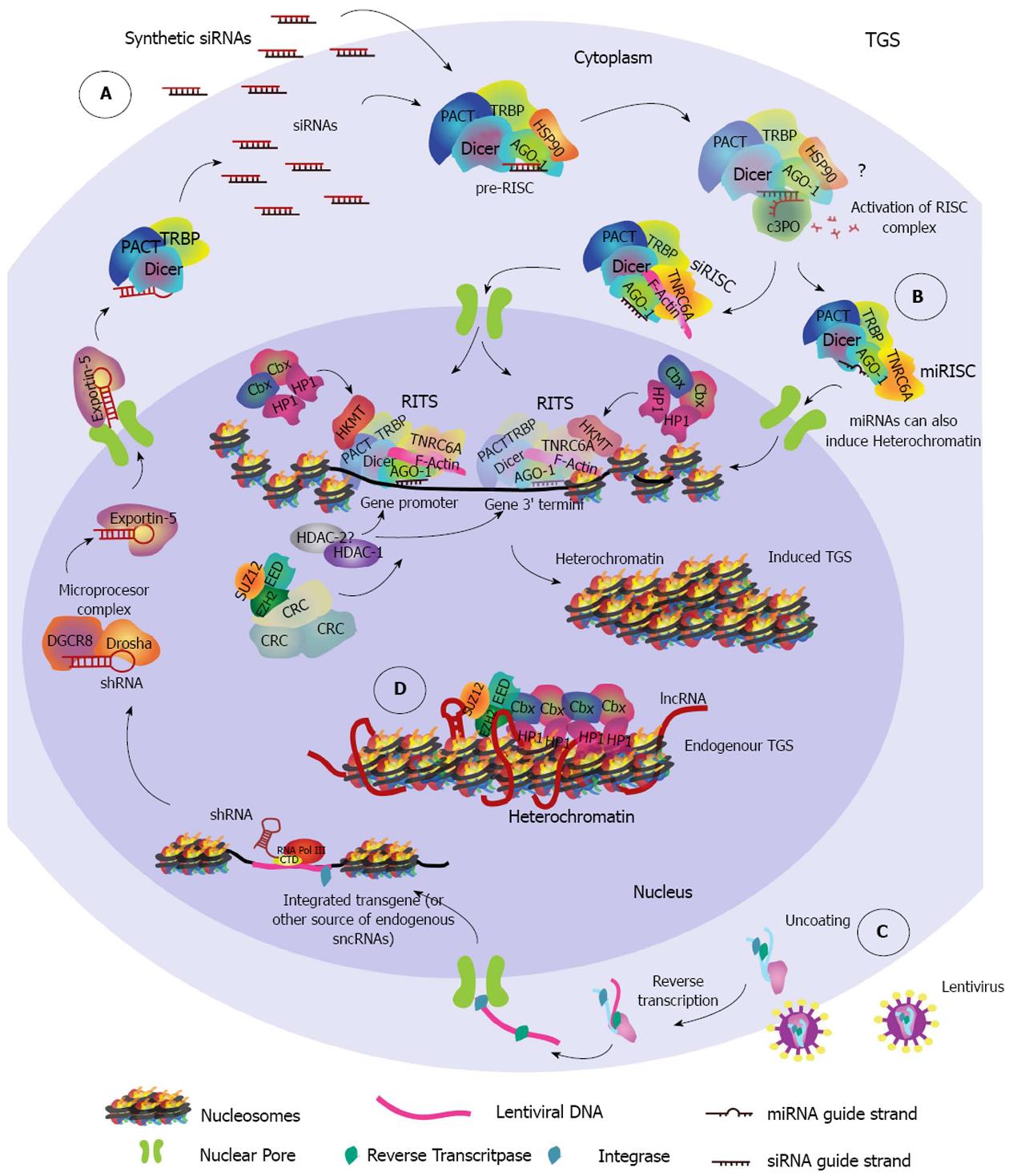Copyright
©The Author(s) 2015.
World J Virology. Aug 12, 2015; 4(3): 219-244
Published online Aug 12, 2015. doi: 10.5501/wjv.v4.i3.219
Published online Aug 12, 2015. doi: 10.5501/wjv.v4.i3.219
Figure 2 Endogenous and induced transcriptional gene silencing pathways.
A: Synthetic siRNAs that have been designed to target the promoter region or the 3’ end termini of a gene are loaded into AGO-1, forming the pre-RISC complex. It is currently unknown if removal of passenger strand is required, nonetheless if it occurs it probably takes place in the cytoplasm following the same steps as used in PTGS. F-actin participates in the nuclear import of the RISC complex which, once in the nucleus becomes the RITS complex as histone-lysine-methyltransferases (HKMTs) and other epigenetic related proteins such as Histone-deacetylases (HDAC), DNA methyltransferases (DNMTs), Histone Protein 1 (HP1) and others assemble with it. It is unknown whether RISC related proteins remain in the RITS complex. The RITS complex may vary in its composition depending on the chromatin microenvironment and the small non-coding RNA (sncRNA) target region, therefore only some proteins are shown as an example. Establishment of repressive epigenetic marks (not highlighted for simplicity) and further recruitment of chromatin remodeling complexes (CRCs) results in heterochromatin formation and induces transcriptional gene silencing (TGS). Two independent target regions are pictured together to show the different regions of a gene that can be targeted to induce TGS; B: miRISC complexes whose guide strand targets a promoter region may be exported into the nucleus, form a RITS complex and induce TGS in the same way as was described for siRISC complexes; C: Lentiviruses can be used to drive transgene integration of a DNA cassette designed to express a shRNA that induces TGS. ShRNAs are transcribed by RNA Pol III and are processed through the microRNA pathway. In the cytoplasm they are converted to siRNA duplexes that are loaded into RISC complexes and follow the same import pathway to induce TGS as explained in A; D: Endogenous transcriptional gene silencing is induced by a long-non-coding RNA (lncRNA) whose secondary structure is recognized by members of the Polycomb Group repressive complex 1 (PRC1), such as enhancer of zeste 2 (EZH2), embryonic ectoderm development (EED) and suppressor of zeste 12 (SUZ12). The interaction recruits HP1 and other proteins of PRC1 complexes like the (Chromobox) Cbx family that contain a chromodomain able to induce heterochromatin formation.
- Citation: Méndez C, Ahlenstiel CL, Kelleher AD. Post-transcriptional gene silencing, transcriptional gene silencing and human immunodeficiency virus. World J Virology 2015; 4(3): 219-244
- URL: https://www.wjgnet.com/2220-3249/full/v4/i3/219.htm
- DOI: https://dx.doi.org/10.5501/wjv.v4.i3.219









